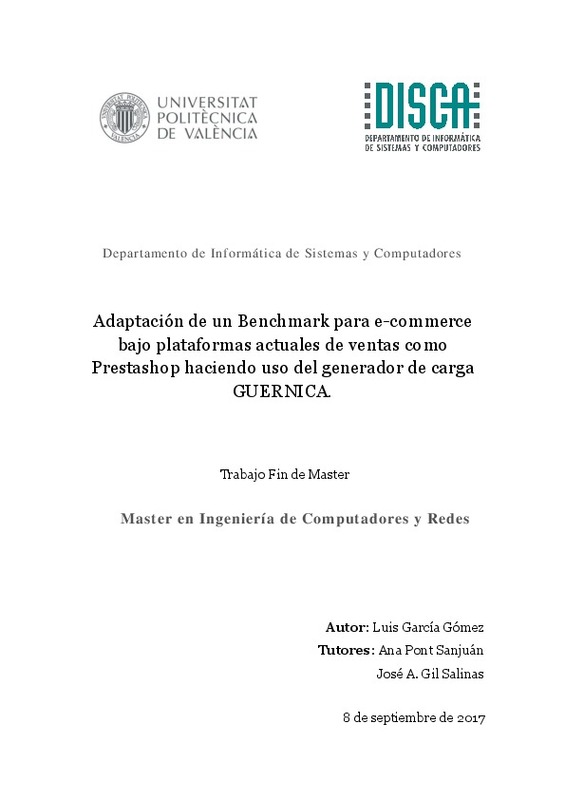|
Resumen:
|
The current trend is to shop online, from a simple clock to a living room furniture, we enter Ebay, we see Amazon offers, we buy some books or maybe some clothes, and so endless daily queries, sales and thousands of bits ...[+]
The current trend is to shop online, from a simple clock to a living room furniture, we enter Ebay, we see Amazon offers, we buy some books or maybe some clothes, and so endless daily queries, sales and thousands of bits transferred from one part to another. It has evolved and people no longer buy just by going to stores, otherwise stores come home or are on our Smartphones and Tablets. Electronic stores are waiting for users to buy as easily as possible, trying to give the best service they can offer to convert a larger number of visits to sales and thus generate greater profits. In this way, the e-commerce boom is currently imminent and needs a thorough study since it moves millions of euros a year, evolving very fast, due to technological changes since the demand, sometimes, is greater than the offer and thus, with good claim, and an optimal navigation of the user, can translate into many euros for the seller, with the consequent economic benefit to the service provider also.
Given that today there are not many benchmarks for the web and more specifically for e-commere, this project aims to adapt an e-commerce benchmarking standard created by the Transfer Protocol Consortium (TPC), which is obsolete at present, to a current sales platform such as Prestashop, making use of the GUERNICA load generator developed by the research group.
What we want to achieve is, according to the TPC-W standard and through GUERNICA, to verify that the navigations that occur in a webpage for electronic commerce under Prestashop making use of GUERNICA, comply with the standards of the TPC- W, obtaining an adaptation of this standard to a current platform for electronic commerce until the current date.
The final adaptation is good and some refinements are necessary. Everything works well and experiments have been carried out to get successful results. Even so, there will be some missing points to adjust to better results and be able to work with this adaptation as a valid and feasible benchmark to test a real e-commerce or cloud infrastructure offered by this service exploitation platform.
[-]
La tendencia actual es el hacer compras vía online, desde un simple reloj hasta unos muebles para el salón, entramos en Ebay, vemos ofertas de Amazon, compramos algún libro o tal vez algo de ropa, y así un sinfín de consultas ...[+]
La tendencia actual es el hacer compras vía online, desde un simple reloj hasta unos muebles para el salón, entramos en Ebay, vemos ofertas de Amazon, compramos algún libro o tal vez algo de ropa, y así un sinfín de consultas diarias, ventas y miles de bits trasladados de una parte a otra. Se ha evolucionado y la gente ya no compra solamente yendo a las tiendas, si no las tiendas vienen a casa o están en nuestros Smartphones y Tablets. Las tiendas electrónicas esperan a que los usuarios compren con la mayor facilidad posible, intentando dar el mejor servicio que puedan ofrecer para convertir un mayor número de visitas en ventas y así, generar mayores beneficios. De esta forma, el auge de los e-commerce en la actualidad es algo inminente y necesita de un estudio exhaustivo ya que mueve millones de euros al año, evolucionando muy rápido, debido a los cambios tecnológicos y a que la demanda, a veces, es mayor que la oferta y de esta forma, con buen reclamo, y una navegación óptima del usuario, puede traducirse en muchos euros para el vendedor, con el consiguiente beneficio económico para el proveedor de servicios también.
Dado que hoy en día no existen muchos benchmarks para web y más en concreto para e-commere, en este proyecto se pretende adaptar un estándar de benchmarking para e-commerce creado por el Transfer Protocol Consorcium (TPC), el cual se encuentra obsoleto en la actualidad, a una plataforma de ventas actual como es Prestashop, haciendo uso del generador de carga GUERNICA desarrollado por el grupo de investigación.
Lo que se desea conseguir es, respetando el estándar TPC-W y mediante GUERNICA, comprobar que las navegaciones que se producen sobre una página web para comercio electrónico bajo Prestashop haciendo uso de GUERNICA, se ajustan a los estándares de la especificación de TPC-W, obteniendo una adaptación de dicho estándar a una plataforma actual para e-commerce hoy en día.
La adaptación final es buena siendo necesarios unos retoques de refinamiento. Todo funciona de forma correcta y se han realizado experimentos obteniendo resultados exitosos. Aun así, faltarían algunos puntos que ajustar para obtener mejores resultados y poder trabajar con esta adaptación como un benchmark valido y factible para poner a prueba un e-commerce real o una infraestructura cloud, que ofrezca esta plataforma de explotación de servicios.
[-]
|







